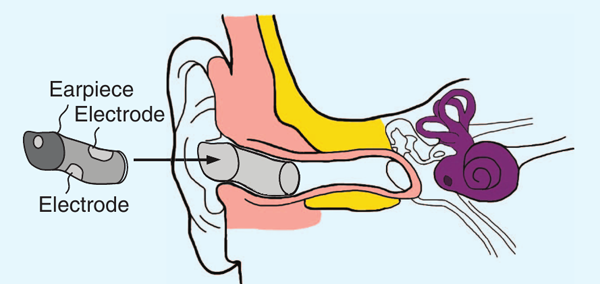The In-the-Ear Recording Concept
By David Looney, Preben Kidmose, Cheolsoo Park, Michael Ungstrup, Mike Lind Rank, Karin Rosenkranz, and Danilo P. Mandic
NOTE: This is an overview of the entire article, which appeared in the November/December 2012 issue of the IEEE Pulse magazine.
Click here to read the entire article.
The use of electroencephalography (EEG) for brain monitoring in everyday life has been hindered by the limited portability and long setup time of current wearable systems as well as by the invasiveness of implanted systems (e.g. intracranial EEG). This article explores the potential to record EEG in the ear canal, leading to a discreet, unobtrusive, and user-centered approach to brain monitoring. The in-the-ear EEG (Ear-EEG) recording concept is tested using several standard EEG paradigms, benchmarked against standard on-scalp EEG, and its feasibility proven.
Wearable EEG systems, intended for applications such as monitoring patients in their homes for extended periods of time, have faced challenges due to the inconvenience of scalp electrodes and the difficulty of their placement. The Ear-EEG is suggested as an alternative to scalp electrodes which can avoid these problems.
The authors suggest that a practical wearable EEG monitoring system must meet several requirements – it must be discreet, unobtrusive, robust, user friendly, and feasible. They intend to show in the article how the Ear-EEG system meets these requirements.
The prototype earpiece (see figure below) uses several electrodes in contact with the ear canal. In the prototype, these electrodes are connected to an external amplifier with wires, but the authors envision electronics in the earpiece to amplify the signals and transmit information to external devices.

Sketch of a right Ear-EEG earpiece with embedded electrodes shown relative to the ear and ear canal. The earpiece does not enter the ear by more than 10 mm and does not enter the part of the ear canal surrounded by bone.
The article contains extensive comparisons of the quality of the signals recorded from the Ear-EEG electrodes with those obtained with conventional scalp electrodes. These include:
- alpha attenuation response (increase in alpha activity when the subject’s eyes are closed
- auditory steady-state response (peaks in EEG frequency spectrum when subject hears amplitude-modulated tone)
- time-domain visual event-related potential (delayed EEG signal response to visual stimulus.
Results of proof-of-concept studies are given, showing the applicability of Ear-EEG electrodes for several applications:
- brain-computer interface (BCI) studies
- assistive uses (inform subject of impending epileptic seizures)
- alertness monitoring
Finally, the authors comment on future applications of a fully integrated Ear-EEG, which could incorporate additional in-ear sensors, such as blood oximeters, temperature sensors, and accelerometers.
ABOUT THE AUTHORS
David Looney, Cheolsoo Park, and Danilo P. Mandic (d.mandic@imperial.ac.uk) are with the Department of Electrical and Electronic Engineering, Imperial College London, United Kingdom.
Preben Kidmose is with the Aarhus School of Engineering, Aarhus University, Denmark.
Michael Ungstrup and Mike Lind Rank are with Widex A/S, Lynge, Denmark.
Karin Rosenkranz is with the Department of Cognitive and Clinical Neuroscience, Central Institute of Mental Health, Mannheim, Germany.






